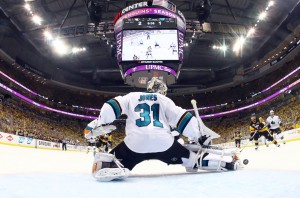The San Jose Sharks whomped the Edmonton Oilers in the fourth game of their playoff series by a 7-0 score. It wasn’t as close as the score suggests.
Precious little about this series makes sense. While the series is tied at 2-2, each team has dominated the other for lengthy stretches; even play has been the exception, not the norm.
Highly Unusual
In the world of statistics, the term ‘three sigma’ signifies a rare occurrence, roughly 0.3 percent of events. Game 4 was a three sigma event for San Jose. Some things they did for the first time this season, others for the first time in several seasons, still others for the first time in the history of the franchise.

The game produced season highs in several categories, including goals (seven, previous high, six), the margin of victory (seven, previous high, four), power plays (eight, previous high, seven) and power play goals (four, previous high, two). The Sharks have posted seven goal margins only two other times in the past four seasons; a 7-0 win last season against Toronto and a 9-2 win over the New York Rangers (the game which made Tomas Hertl famous).
In the 60 minutes of Game 4, the Sharks skated with the lead for 59:45, a playoff franchise record. In the first three games of the series, the Sharks never skated with the lead; the lone time the scoreboard showed a Sharks lead was after the overtime game winner in Game 1.
Abrupt Change
If Sharks coach Peter DeBoer was concerned about insufficient practice time for an ailing power play, Edmonton provided the answer. The Sharks skated with a man advantage for roughly 20 percent of Game 4, officially going on the power play eight times (including one major). This followed a three-game stretch of power play futility, just 1/14 with two short-handed goals allowed. Speaking of the two short-handed goals, this rarity from Game 3 fits the three sigma theme. As did the Sharks back-to-back scoreless efforts in Game 2 and 3.
The Sharks went from ice-cold to red-hot. Their goal total in the past three games 0-0-7. Or, to put in another way, double-o seven. Yup, the Sharks pulled off the ultra-rare ‘James Bond’.
While it is fun to look at the oddities of the series (there are many more ‘firsts’ and ‘highly unusuals’ which I’ll skip), this unevenly played series is exactly even, down to a best of three to decide who advances.
A Rare Constant
There are few constants in this series, but the Sharks 5-on-5 defense is one. They allowed a goal in Game 1 and another in Game 3. The Oiler’s even strength offense has been mostly absent. If the Sharks hope to advance to the next round, continuing this trend is critical. Goalie Martin Jones has faced an average of 25 shots on goal per game, only Ottawa’s Craig Anderson averages fewer, just barely, at 24.7.

One specific storyline has worked out for San Jose, their effectiveness handling Connor McDavid. The young superstar has two points (a shorthanded goal and a power-play assist) and is even (just a minus-1 rating in the blowout loss). Meanwhile, the defenders most responsible for containing McDavid have held up well. Marc-Edouard Vlasic has three points (all assists, two on the power play) and is plus-1 (a plus-1 in the blowout). His defensive partner, Justin Braun has a point (an assist) and is plus-2.
The Oilers have been shorthanded roughly 40 minutes over the four games. San Jose has been on the power play 22 times (21 minors and 1 major). No doubt, the four power play goals in Game 4 are a three sigma event, not likely to be repeated. But over the course of the series, Edmonton has provided San Jose the opportunity to find their power play ‘groove’, which was absent for most of the season. In the last three games, the Sharks power play was minus-2, even and plus-4 respectively. If the Sharks’ power play has returned to life, continued undisciplined play by the Oilers will have major consequences.
Up Next
Understanding the series so far leads to a simple conclusion, it is impossible to forecast what happens next. Trend lines are meaningless. Of the dozen periods played, perhaps two have been close to even. Most have had one team dominate the other.
Neither team has shown the sort of constant solid play required to take home the Stanley Cup. In this head-scratcher of a series, the deciding games should prove entertaining, if not predictable.
Zeke’s Notes
ICYMI, @49ers legend @JerryRice opened the doors for Game 4 last night at the Tank. pic.twitter.com/b9kOf7TMiH
— San Jose Sharks (@SanJoseSharks) April 20, 2017
• The Sharks have developed a playoff tradition by having a Bay Area luminary open the locker room door for the team as it heads onto the ice to start of the game. For the second time, it was opened by a person with the last name Rice. Last season, controversial political figure Condolezza Rice opened the door, a decision met with limited enthusiasm. San Francisco 49er legend Jerry Rice opened the door for Game 4, a very popular choice. A few of the others who’ve had the honors: Rickey Henderson, Ronnie Lott, Kristi Yamaguchi and Steve Wozniak.
• The Sharks made only one change to their game roster in the series, with Joe Thornton replacing Mikkel Boedker beginning with Game 3. But DeBoer has juggled his lines. In Game 4, the top line featured the franchise leaders in scoring, Joe Pavelski, Joe Thornton and Patrick Marleau. Timo Meier (mentioned positively in Zeke’s Notes two days ago) moved up to the third line, with Tomas Hertl and Melker Karlsson. Jannik Hansen joined Couture and Joonas Donskoi for another line. The fourth line included Chris Tierney, Joel Ward and Marcus Sorenson.
• Though there was a bit of in-game line juggling in Game 4, I wouldn’t read much into it. The constant Edmonton march to the penalty box almost necessitated the creation of new lines, since the top power-play unit uses players from multiple lines. In addition, Couture, Thornton and Pavelski sat for much of the third period. Couture and Thornton had under 10 minutes of even strength ice time. The leading Sharks forward in even strength ice time? Jannik Hansen.